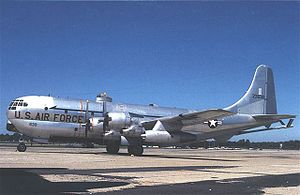The Boeing KC-97 Stratofreighter is a four-engined, piston-powered United States strategic tanker aircraft based on the Boeing C-97 Stratofreighter. It replaced the KB-29 and was succeeded by the Boeing KC-135 Stratotanker.
| KC-97 Stratofreighter | |
|---|---|

| |
| KC-97L in Ohio Air National Guard markings | |
| Role | Strategic tanker |
| Manufacturer | Boeing |
| Introduction | July 14, 1951[1][2] |
| Retired | June 1978[3] |
| Primary users | United States Air Force Spanish Air Force |
| Produced | 1951–1956[4][5] |
| Number built | 811 |
| Developed from | Boeing C-97 Stratofreighter |
The KC-97 Stratofreighter was an aerial refueling tanker variant of the C-97 Stratofreighter (which was itself based on the Boeing B-29 Superfortress), greatly modified with all the necessary tanks, plumbing, and a flying boom first developed for the KB-29 bomber. The cavernous upper deck was capable of accommodating oversize cargo accessed through a very large right-side door. In addition, transferable jet fuel was contained in tanks on the lower deck (G-L models). Both decks were heated and pressurized for high altitude operations. The boom operator lay prone, viewing operations through a window at the bottom of the tail, a configuration later used on the KC-135
Note: Occasionally the KC-97 has been referred to as "Stratotanker". However, all reputable sources refer to the KC-97 as Stratofreighter, not -tanker. This includes both Boeing and the USAF themselves.[6][7]
The USAF began operating the KC-97 in 1950. It purchased a total of 811 KC-97s from Boeing,[5][8][9] as opposed to only 74 of the C-97 cargo version.[10][11][12] The KC-97 carried aviation gasoline for its own piston engines but it carried jet fuel for its refueling mission, this required an independent system for each type of fuel. However in an emergency, it was able to also offload its aviation gas to a receiver in a procedure universally known as a "save".[13]
These tankers were vitally important to the world-wide Boeing B-47 Stratojet strategic operations. An example was the support of Arctic reconnaissance flights from Thule Air Base.
While it was an effective tanker, the KC-97's slow speed and low operational altitude complicated refueling operations with jet aircraft. B-52s typically lowered their flaps and rear landing gear to slow the aircraft enough to refuel from the KC-97. In addition, a typical B-52 refueling engagement profile would involve a descent that allowed the aircraft pair to maintain a higher airspeed (220–240 knots). In the early 1960s, the Tactical Air Command added General Electric J47 two twin- jet pods from retired KB-50 aerial tankers to produce the KC-97L. These jet pods increased the speed of the KC-97 (for short periods of time) and made it more compatible with jet fighter planes like the F-84, F-100, and F-101.
In 1956, the Strategic Air Command began phasing out its KC-97s in favor of the KC-135 Stratotanker. KC-97s continued flying with Tactical Air Command, the Air Force Reserve, and the Air National Guard. The rest of the KC-97s were retired completely in 1978, when the Texas Air National Guard and the Utah Air National Guard exchanged their KC-97Ls for the C-130 Hercules and the KC-135 Stratotanker, respectively.
One KC-97 airframe (AF Ser. No. 52-0828)[14] was adapted into the Aero Spacelines Super Guppy, a transport plane designed to carry Apollo Program rocket stages from California to Florida. The aircraft carried the Saturn S-IVB stage, which served as the second stage of the Saturn IB, the third stage of the Saturn V, and the fourth stage for the never-built Nova rocket.
This modified KC-97, constructed in 1953, was eventually purchased by NASA in 1997. It is still in service supporting NASA, other Federal agencies, and Federal contractors. It is one of two KC-97s left still in flyable condition, the other being former KC-97G 52-2718, "Angel of Deliverance", currently flown by Berlin Airlift Historical Foundation as YC-97A 45-59595.
The following USAF wing organizations flew the various KC-97 models at some time during their existence:[17]
The KC-97 Stratofreighter is shown in both its cargo and tanker tasks in the 1955 film Strategic Air Command, refueling a B-47 in flight, and in the 1957 film Bombers B-52, refueling B-52s.
Data from USAF Museum,[75] FAS: KC-97 Stratotanker[76]
General characteristics
Performance
Related development
Aircraft of comparable role, configuration, and era
Related lists